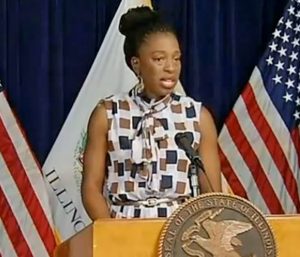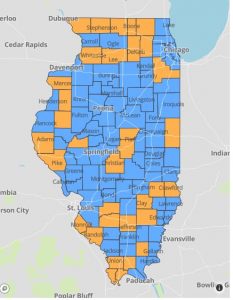Pandemic picture worsens in Illinois, hospitalizations climb
By Jerry Nowicki Capitol News Illinois — October 19, 2020
Dr. Ngozi Ezike, director of the Illinois Department of Public Health, said on Monday, Oct. 19 now is no time to get complacent, and she reiterated no age group is immune from debilitating effects of the virus. (Capitol News Illinois file photo)
SPRINGFIELD – Hospitalizations for COVID-19 and the rolling seven-day test positivity rate for the virus increased again in Illinois on Monday, Oct. 19 mirroring national trends.
Gov. J.B. Pritzker said at a Jackson County news conference Monday, Oct. 19 the state would increase mitigations in southern Illinois and announced he would once again hold daily weekday COVID-19 briefings until metrics start to decrease.
“While we continue to see a safer pandemic landscape than back in April and May, in terms of positivity, hospital capacity and community spread…Things have changed,” Pritzker said while noting Illinois’ positivity rates are still generally lower than its Midwest neighbors. “Every region of the state has started to move in the wrong direction.”
The statewide rolling positivity rate — which is driven lower by a massive saliva testing program at the University of Illinois that often yields positivity rates on campus of less than 1 percent — increased to 5.4 percent as of Monday, marking 15 straight days of increases.
That came as the state reported an average of 3,662 new cases each day from Saturday, Oct. 17 through Monday among an average of 68,490 test results reported each day. Another 71 COVID-19 positive people died over the three-day period. That brought the death toll since the pandemic began to 9,236 among 347,161 confirmed cases with more than 6.8 million test results reported.
Hospitalizations, intensive care bed usage and ventilator usage for COVID-19 all spiked in the state as of Sunday evening as well.
Still, Pritzker said the state can better track the virus than it once could due to increased testing and better knowledge of the virus. That means the state’s response will continue to be targeted to the 11 mitigation regions.
“Statewide, our COVID-related deaths per day are down from an average high of 117 per day in mid-May, though up from a low in August,” he said.
But Dr. Ngozi Ezike, director of the Illinois Department of Public Health, said now is no time to get complacent, and she reiterated no age group is immune from debilitating effects of the virus.
“Yes, the majority of these individuals (who have died from COVID-19) are over 70 years of age, but every week we are also reporting the deaths of individuals in their 20s, 30s and 40s,” she said. “This is not a virus that only attacks older individuals or only attacks individuals with chronic health conditions; younger people are getting affected, they are getting infected, and they are also dying, although agreeably in lower numbers.”
She once again urged Illinoisans to get their flu shots to help limit the burden on the health care system. Face coverings and keeping distance from others also remain key to mitigating spread, she said.
Pritzker and Ezike were in Murphysboro Monday to announce new mitigations in the region encompassing 20 of the state’s southernmost counties. That region, Region 5 of the mitigation plan, saw its positivity rate increase to 9.1 percent, exceeding 8 percent for the third straight day.
On Thursday, Oct. 22, it will join Region 1 in the northern part of the state including Winnebago County to the western border, as areas that have added restrictions, including closure to indoor dining and drinking at bars and restaurants and capacity limitations of 25 people or 25 percent of a room’s capacity.

The Illinois Department of Public Health map shows the number of counties in the state meeting two or more warning metrics for COVID-19 spread as of Oct. 19. There are 34 counties at a warning level, up from 28 a week ago. (Courtesy of Illinois Department of Public Health)
Dr. Craig Davis, who works for Southern Illinois Healthcare, noted at the news conference that COVID-19 hospitalizations have “tripled in the last couple of days” in the area.
“What remains most alarming to me as a physician and father is the complacency I see in some of our community members, and the polarization over simple infection prevention methods, especially surrounding masks and social distancing,” he said. “I understand the mental, physical, social fatigues that we’re all dealing with. Our daily lives have been totally upended by this. And I understand everyone has a yearning for returning to normalcy. But I urge everyone to stay the course.”
Despite having added restrictions in place since Oct. 3, Region 1 saw its rate remain level at 11.1 percent as of Oct. 16 when the most recent data were available. That marks six straight days above 10 percent.
Positivity rates were trending upward in the rest of the state’s mitigation regions as well, with only Region 4, which includes the Metro East area on the Missouri border, decreasing to 7 percent from 7.2 percent the day prior.
Region 7, which includes Will and Kankakee Counties, saw its positivity rate increase to 8.3 percent, its second day above the 8 percent threshold. Region 8, which includes DuPage and Kane counties, has been above the threshold for two days as well, reaching 8.5 percent.
Elsewhere, Region 2 in north-central Illinois increased to 6.9 percent, Region 3 in west-central Illinois increased to 7.3 percent, Region 6 in east-central Illinois remained level at 7.6 percent, Region 9’s north suburban Lake and McHenry counties increased to 7.3 percent, Region 10’s suburban Cook County increased to 6.8 percent, and Chicago, which makes up Region 11, increased to 6.2 percent.
The 2,096 hospital beds in use by COVID-19 positive individuals once again marked the highest usage since June 12. The 485 ICU beds used by COVID-19 patients marked an increase of 77 from the previous day and once again marked the most in use since June 18.
There were 179 ventilators being used by COVID-19 patients at the end of Sunday, an increase of 22 from the previous day and the most in use since July 3.
On average, there were 1,993 hospital beds in use by COVID-19 patients each day for the week ending Oct. 18, which was an increase of 241, or 14 percent, from the week prior and 399, or 25 percent, from two weeks prior.
The average daily intensive care bed usage increased to 416 for the week ending Oct. 18, an increase of 28, or 7 percent, from the week prior. That’s up by 45, or 8 percent, from two weeks prior.
jnowicki@capitolnewsillinois.com
Illinois health officials urge flu shots as COVID-19 continues to spread



